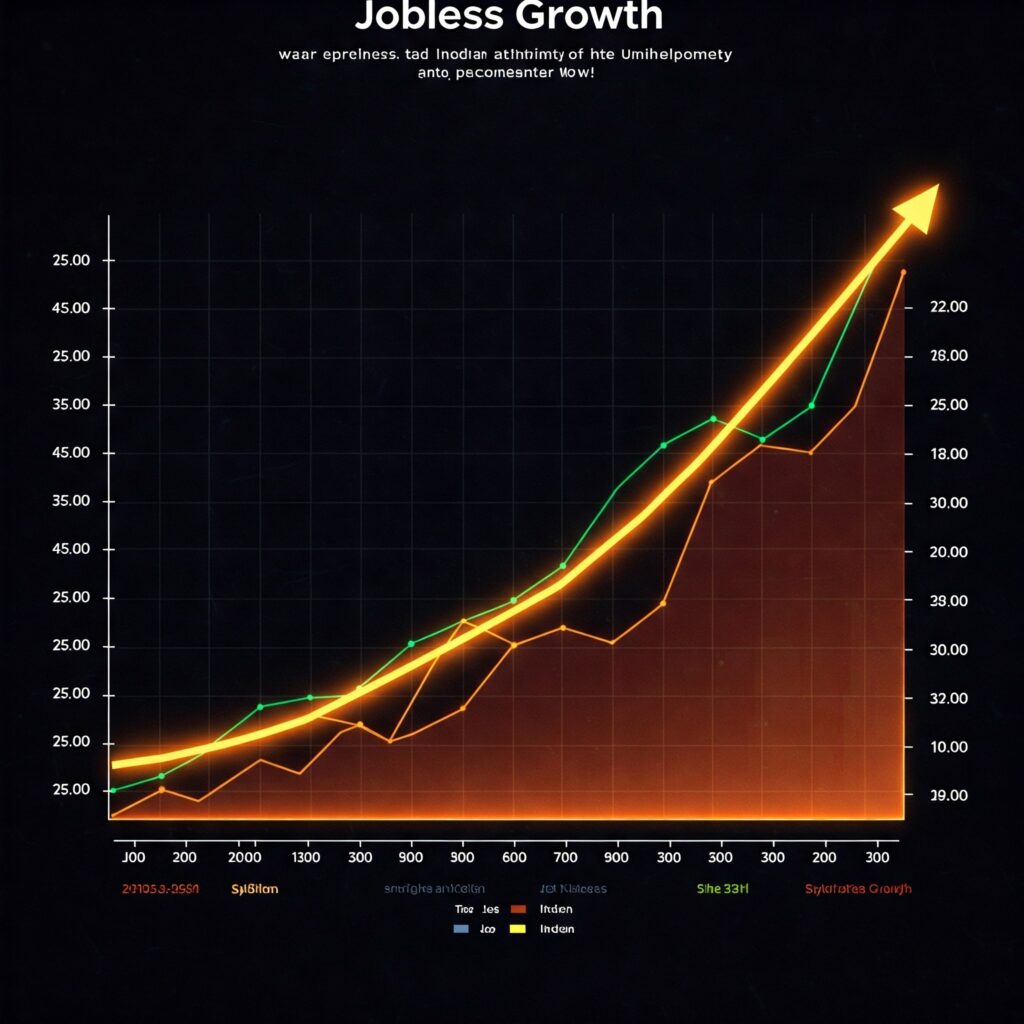Introduction
India’s economic growth story since the 1990s has been marked by robust GDP expansion. However, a striking paradox has emerged in recent years—despite steady or even high economic growth, employment generation has not kept pace. This phenomenon, commonly referred to as jobless growth, is one of the most pressing challenges facing the Indian economy today.
Jobless growth is characterized by an increase in the gross domestic product (GDP) without a corresponding increase in employment opportunities. In India, this issue is further compounded by the quality of employment—many jobs are informal, insecure, and poorly paid. This essay explores the underlying causes of jobless growth in India and suggests comprehensive policy measures to create quality employment that is sustainable, inclusive, and equitable.
Understanding Jobless Growth in the Indian Context
Jobless growth is not merely about the absence of jobs; it is a deeper structural issue where the sectors driving growth are not labor-intensive or fail to absorb the increasing working-age population. In India, the services and capital-intensive industries have contributed significantly to GDP but have limited employment potential. Meanwhile, traditional labor-absorbing sectors like agriculture and small-scale manufacturing are either stagnating or facing productivity bottlenecks.
Causes of Jobless Growth in India
1. Sectoral Imbalance in Growth
India’s growth has been primarily led by the services sector, which contributes over 50% to the GDP but employs only about 25-30% of the workforce. High-end services like IT, finance, and telecommunications are skill-intensive and employ a small segment of the educated population. In contrast, labor-intensive sectors like manufacturing and agriculture have seen stagnant or declining employment.
2. Slow Growth of the Manufacturing Sector
Despite initiatives like “Make in India,” the manufacturing sector has not become a robust engine of employment. Several factors contribute to this:
- High cost of compliance and regulation
- Rigid labor laws in the formal sector
- Low investment in labor-intensive industries like textiles, leather, and electronics
- Technological automation reducing the need for human labor
3. Technological Displacement
The increasing adoption of automation, AI, and robotics in industries has led to the displacement of low-skilled jobs. While technology boosts productivity, it reduces demand for labor, especially in organized sectors. This has resulted in a mismatch between technological advancement and human capital.
4. Informality and Underemployment
A significant share of India’s workforce—over 80%—is employed in the informal sector, which includes agriculture, construction, and unregistered small enterprises. These jobs are often low paying, seasonal, and lack social security. Informality also leads to underemployment, where people work below their skill levels or for fewer hours than they wish to.
5. Skill Mismatch and Poor Education-Employment Linkages
India faces a paradox where millions of youth are unemployed, while industries report a shortage of skilled workers. The education system often fails to equip students with employable skills, especially in rural and semi-urban areas. Technical and vocational training is also underutilized and not aligned with market needs.
6. Demographic Pressure
India is experiencing a youth bulge, with more than 65% of the population below the age of 35. While this is a demographic dividend, it becomes a liability if the economy cannot create sufficient employment opportunities. The unemployment rate among youth is significantly higher than the national average, reflecting both a lack of opportunities and aspiration mismatch.
7. Regulatory and Business Environment Constraints
High compliance burdens, bureaucratic red tape, complex labor laws, and inadequate infrastructure discourage businesses from expanding or hiring more workers. Small and medium enterprises (SMEs), which are crucial for job creation, often face difficulties in accessing credit, technology, and markets.

Consequences of Jobless Growth
- Rising Unemployment and Social Unrest: Persistent joblessness can lead to frustration among the youth, increasing the risk of crime, social unrest, and political instability.
- Widening Inequality: Economic growth without employment benefits a narrow segment of the population, exacerbating income and social inequality.
- Low Consumer Demand: Unemployment leads to lower disposable income, which reduces demand for goods and services, creating a vicious cycle of low growth and low employment.
- Brain Drain and Migration: Educated and skilled youth often migrate abroad or to urban areas in search of jobs, leading to regional imbalances and urban stress.
Policy Measures to Generate Quality Employment
Addressing jobless growth requires a multi-dimensional and long-term strategy. The focus should be on generating not just more jobs, but better jobs—those that offer fair wages, security, dignity, and prospects for advancement.
1. Revitalizing the Manufacturing Sector
- Boost Labor-Intensive Industries: Promote sectors like textiles, food processing, footwear, and light engineering that can absorb large numbers of semi-skilled and low-skilled workers.
- Ease of Doing Business: Simplify regulations, reduce compliance costs, and offer incentives for hiring, especially in micro, small, and medium enterprises (MSMEs).
- Cluster Development: Develop industrial clusters and special economic zones (SEZs) with strong infrastructure, logistics, and market linkages.
2. Reforming Labor Laws and Social Security
- Simplify and Rationalize Labor Codes: Ensure flexibility in hiring while protecting worker rights. The new labor codes are a step in this direction, but effective implementation and clarity are crucial.
- Universal Social Security: Extend coverage to informal workers through schemes like e-Shram, and facilitate portability of benefits across states and sectors.
3. Enhancing Skill Development and Vocational Training
- Reform Skill India Mission: Align training programs with industry needs through regular consultation with employers and industry associations.
- Vocational Education in Schools: Introduce vocational subjects at the secondary and higher secondary levels to prepare students early for the job market.
- Apprenticeship Promotion: Encourage industries to hire apprentices through incentive-based models and public-private partnerships.
4. Promoting Entrepreneurship and Self-Employment
- Startup Ecosystem Support: Simplify tax procedures, improve access to venture capital, and offer mentoring to young entrepreneurs.
- Credit Access for MSMEs: Expand schemes like MUDRA and Stand-Up India to enable micro-enterprises to grow and hire more workers.
- Women Entrepreneurs: Support women-led enterprises through dedicated funding, training, and marketing platforms.
5. Agricultural Reforms and Rural Employment
- Modernize Agriculture: Invest in irrigation, storage, food processing, and agri-tech to improve productivity and rural incomes.
- Agri-Value Chains: Link farmers to markets through FPOs (Farmer Producer Organizations), e-NAM, and cold chain infrastructure.
- Rural Job Guarantee: Strengthen MGNREGA and integrate it with asset creation, watershed development, and afforestation projects.
6. Leveraging Digital and Green Jobs
- Digital Inclusion: Expand broadband access in rural areas and provide digital literacy programs to tap into the digital economy.
- Green Employment: Promote renewable energy, sustainable transport, and waste management sectors which can generate millions of green jobs.
7. Inclusive Urban Employment Policies
- Urban Employment Guarantee: Pilot programs like the Urban MGNREGA to offer work in cities for migrants and informal workers.
- Affordable Housing and Infrastructure: Stimulate urban job creation through investments in construction, housing, and smart city projects.

Conclusion
India stands at a critical juncture in its development journey. While economic growth is necessary, it is not sufficient unless it translates into productive, gainful, and inclusive employment. Jobless growth erodes the benefits of development and undermines social stability.
Tackling this challenge requires an integrated approach involving structural reforms, sectoral incentives, skill enhancement, and institutional support. Policymakers must prioritize employment-centric growth models that empower youth, promote equity, and harness the potential of India’s vast labor force. If addressed effectively, India can convert its demographic bulge into a demographic dividend, driving sustainable prosperity for decades to come.




